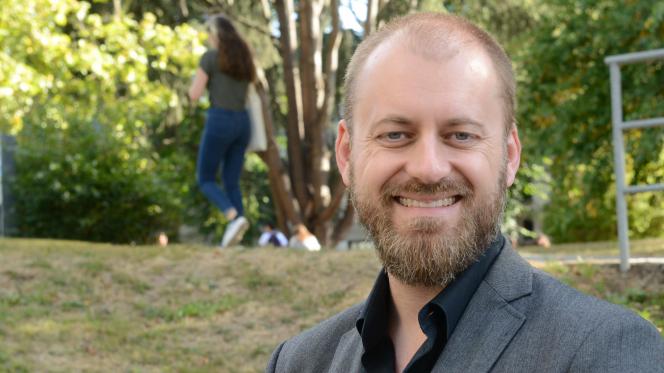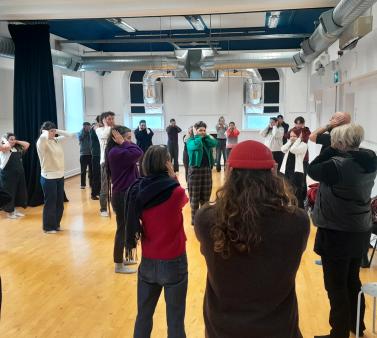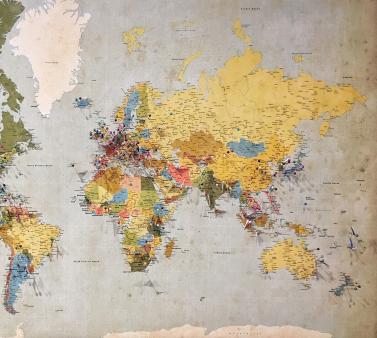How did you get started in the field of neuroscience? And what were some of your impressions early on?
I got into the field because, starting in high school, I was fascinated by how we think and why people are different, which led me towards philosophy and psychology. But very early in my undergraduate training, I was quite taken by how neuroanatomy and biological mechanisms impact human perception, thought and individual differences.
I continued in psychology during my graduate studies but specifically focused on vision science within the field of neuroscience when I went to the Centre for Vision Research at York University. I would say that this was probably my first introduction to a high-calibre research environment with York being such a world-renowned institution for vision research.
There was also a constant influx of people from all over the world, very prestigious lecturers there to give talks, and it opened up the greater world of international work related to neuroscience for me.
I completed both my Master’s and my PhD there, and one thing that really struck me was how the Centre really took to heart the idea of people from different disciplines working together. As opposed to having our lab structured solely within a department, my labspace was integrated within a research association. That meant that not only was I next door to people from other disciplines (i.e. psychology, biology, computer science, kinesiology and engineering), but we really had the opportunity to interact in meaningful ways such as in weekly seminar meetings. There was also a constant influx of people from all over the world, very prestigious lecturers there to give talks, and it opened up the greater world of international work related to neuroscience for me. It was during that time that I went to my first international meeting, a joint meeting in Siena (Italy), which was a satellite meeting to a Bárány Society Meeting being held in Paris (France) - a vestibular conference.
It was also around this time that I realized some of the relevant connections between these research areas and industry, particularly with regards to space sciences. We were doing a lot of work related to projects that were funded by NASA and the Canadian Space Agency. There were also people from the European Space Agency at that meeting, and a lot of clinicians as well. That really made a strong impression on me: that you could do basic but fundamental research that could be applied to other areas like space sciences and medicine, and go to lovely places like Siena and Paris.
It was also something I kept in mind when I was considering where to go for my postdoctoral training. I was particularly drawn to the Max Planck Institute for Biological Cybernetics in Tübingen, where my advisor had spent time, but I was also intrigued by the CNRS following a period I had spent at the Université Réné Descartes in Paris. In the end, Tübingen won me over and I moved there for two years to do research.
Can you tell me a bit about your current research and collaborations?
My research program is related to multisensory integration. This tries to address the question of how the central nervous system takes in information from different senses: from vision, hearing and your vestibular system, and puts it together. This information comes through specialized channels but then ultimately has to be put together to reconstruct the world around us. It's an interesting field to be in and, by design, is very multidisciplinary. It requires approaches from engineering, computer science, psychology and kinesiology.
One of the particular areas we’ve been interested in is how do people navigate and move in these virtual environments. Is the mode or methods of navigation similar to the real world, and if not, what do we learn from these differences?
A lot of our work in the past five years has been intensely using virtual reality technology. The technology has always been around as a research tool, but the latest commercially available systems are much better and cheaper today. They're also in the hands of many more people and there's more of a demand to answer some of these research questions we’re examining.
One of the particular areas we’ve been interested in is how do people navigate and move in these virtual environments. Is the mode or methods of navigation similar to the real world, and if not, what do we learn from these differences? This is very much in Anne-Helene Olivier’s field of study (editor’s note: Anne-Helene Olivier is a Rennes 2 Lecturer and Researcher within the M2S research group), which is why we fostered this collaboration. I haven't done a lot of work on human bipedal locomotion. I’ve done a good deal of work on self-motion where you’re in a motion simulator and you are moved around passively. She’s done work in terms of actually walking around with your feet and examining how you can navigate around other people. So this was a good opportunity to tackle new research questions and also bring some of my previous experience to bear in some of the experimental paradigms on which she’s working. I hope to actually bring back some of these experiences with me to my lab and answer some of those research questions that previously we weren't doing and to learn from the technology.
How did you find the lab facilities at Rennes 2?
At the University of Waterloo, we have access to similar sorts of facilities. My lab is housed within a larger gym-like environment where we’re doing some work with community care groups. But one thing that is unique about the Immermove platform at the M2S lab facility is that they have a dedicated gymnasium just meant for research. That is quite unique. I’m very well supported in Waterloo, but we don’t have the same kind of access to the facilities. We’d have to make special arrangements to do virtual reality in a similar sort of environment.
I would also say that the intensity of the M2S research group that’s connected by Rennes 2 and also to INRIA, is very well positioned to examine these sorts of questions. Not just Anne-Helene Olivier, but the whole research group that has formed around it across the 3 different locations that we’ve visited since I’ve been here. The sports sciences program here is clearly well-funded and in a good position to welcome students and faculty.
What are some of the topics you’ve addressed during your lectures here at Rennes 2? How have they gone?
I’m giving four lectures in total, two that have been back-to-back lectures. The main lectures I have given so far centered on the individual senses that we have as humans and how they operate. They’ve really focused on the fact that the quality of the information that is given by each sense is determined based on one’s physiology. So we look at how those senses are constructed based on biological principles, the benefits and limitations for each, and how those benefits and limitations propagate forward and bear on how they ultimately get put together.
During my second lecture, we focused on questions like: If we know that those individual senses are different in the way that they operate, what happens then as we start to ask basic research questions on how do we put this information together? I reviewed a series of experiments from my labs and other labs that have tried to answer the question about how we perceive the relative timing of multisensory information? So, for example, when in time do events occur? An example I gave in my lecture was that: if I snap my fingers (as I'm doing now), you can see the snapping of my fingers, and that's because of light that is reflecting off of my finger and then to your eye and then on to the brain where it is further processed. However, the time it takes for processing visual information is relatively slow compared to the auditory system. The changes in vibrations in the air, that are then transduced by your auditory system, are very quick in comparison. Even though we have one distinct event in time that’s generating two different types of energy. Light and sound arrive at the brain at different times but have to be resolved somehow. The brain has to somehow figure out that even though the sensory information comes into the system at different times, it needs to represent that this is happening at the same time.
We’ve looked at a number of different experiments that find that, curiously, when people move, particularly if they move their own head for example, the perceived time that they think they begin to move is actually very slow. In other words, if I force you to decide what happened first, the movement of your own head or a sound that I play, you’ll require that your head move first, before the sound, for you to think that they're happening at the same time.
I’ll be talking about how do we take that information from those predictive models and apply it into cases of virtual reality for example. Both in terms of how do we use virtual reality as a tool to understand how the brain works, but also how can we take that information about how we know how the brain works, to make virtual reality that much better than it currently is.
So this is a bit of a curiosity because we don’t think that the world is disjointed in time. What we’re trying to do is come up with models of how the brain must be solving that problem. In my lectures later today, I’ll be talking about some of those models that are used for integrating information from different senses. Then, in the fourth lecture, I’ll be talking about how do we take that information from those predictive models and apply it into cases of virtual reality for example. Both in terms of how do we use virtual reality as a tool to understand how the brain works, but also how can we take that information about how we know how the brain works, to make virtual reality that much better than it currently is.
So the lectures have gone well thus far. I believe there were a few undergraduates present, but many more Master’s students. We also had a number of doctoral students and faculty that were present as well. Of course, I started off by apologizing that my language skills are not at the level where I could give the entire lecture in French, but my understanding is that it was great exposure for the students to be able to listen to these types of research discussions in English. There were a few moments where I attempted some pedagogical techniques that I could see were a little tricky for them, but we figured it out. It took a bit longer, but it also gave me a hint on how to pace my lecture. The joining of the lectures, which made them into two-part sessions with a break in between, was helpful because it gave them a chance to take a slight pause and digest what they’ve just heard. But I could still rely on the fact that the information was fresh in their minds to set up the next lecture. Had the second half of the lecture been given a full week later it might have been harder for them to retain some of that information.
Would you say that there is potential for greater collaboration between Rennes 2 and the University of Waterloo?
Absolutely, I heard repeatedly that sports sciences is a very well-regarded field at Rennes 2, and so is the Department of Kinesiology at the University of Waterloo. Our program is quite comprehensive with representations in biomechanics, neuroscience, physiology and nutrition. It was the first department of kinesiology in the world. In fact, I think I’ve met a number of colleagues here who are familiar with our department and vice versa. I could see quite a lot of potential for future cooperation, particularly if there are interests from Rennes 2 on questions about aging and geriatrics. Aging was one of the main strategic goals in our previous strategic plan.
While we’re currently in the process of releasing a new strategic plan, its likely going to continue to capitalize on our current strengths and unique resources. For example, we have a participation pool of older adults from the community who want to give back and participate in research. It’s quite helpful because working with older adults typically implies that students will ask their parents and their parents’ friends if they’re willing to participate, which is not always easy. Whereas, we have over a couple of hundred people living in the community that we can ask. Another resource we have is the Research Institute for Aging, which is part of the University of Waterloo. That Institute is embedded within the Schlegel Nursing home Care Facility on campus. The Schlegel Villages is a family-owned company of nursing and long-term care homes across Ontario, but there’s one facility in Waterloo and the research unit is embedded within it. It enables researchers to be able to work with the older adult population from the early-retirement phase. Many of the researchers that are interested in aging are hoping not just to work with residents that are at near-end or end-of-life stages, but much earlier on in an attempt to figure out what can we do to prevent some of the injuries or things that make living later in life more risky.
Any advice for young people just starting out in the field?
One of the important things I’ve taken with me from the early years of collaborating internationally is that, when you’re traveling, it’s important to take a chance and meet people from around the world, discuss your research. When people travel from overseas and they come to a place like Rennes or anywhere else, it's usually only for a short period of time, at least that’s the intent. Which means that they have no friends locally. So they are in a position to meet new people. In fact, anybody, both locals and other international people can take advantage of that and exchange with others. You never know where those collaborations will go into the future. The world is actually pretty small when you think about it and it's pretty easy to travel.





